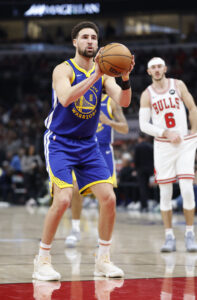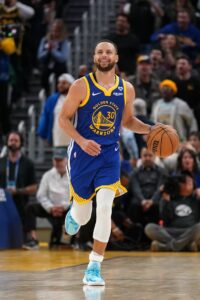No NBA team has spent more money during the past two seasons on player salaries and luxury tax payments than the Warriors. The return on those hundreds of millions of dollars committed by ownership? A 90-74 regular season record, a single playoff series win in 2023, and a one-and-done play-in appearance in 2024.
Of course, the Warriors still have many of the same pieces on the current roster that they did on the version that won a championship in 2022. But the club’s longtime core stars are all in their mid-30s and need more help from the supporting cast than they once did.
Following a disappointing finish to the 2023/24 season, Golden State ownership and management will need to make a crucial decision this summer.
Is it worth maximizing the years the Warriors have left with all-time great Stephen Curry by continuing to pour massive amounts of money into player payroll and remaining in championship-or-bust mode? Or is the time right to take a step back by shedding some salary, ducking below the tax aprons, and gaining access to more roster-building tools, even if it means sacrificing a couple assets and perhaps ending an important longtime relationship along the way?
Cutting costs doesn’t necessarily mean the Warriors can’t be a contender in 2024/25 and beyond, but one or two missteps in that process could put the team at risk of wasting Curry’s remaining high-level years. It will be a tricky tightrope to walk for general manager Mike Dunleavy Jr., who is in just his second year as Golden State’s head of basketball operations.
The Warriors’ Offseason Plan
 If money continues to be no object for the Warriors, re-signing veteran sharpshooter Klay Thompson, who will be an unrestricted free agent this offseason, should be atop their to-do list. The two sides have expressed mutual interest in continuing their relationship, which began when Golden State drafted Thompson 11th overall back in 2011. But Thompson reportedly turned down a two-year, $48MM extension prior to the season and seems intent on testing the open market to get a sense of his options.
If money continues to be no object for the Warriors, re-signing veteran sharpshooter Klay Thompson, who will be an unrestricted free agent this offseason, should be atop their to-do list. The two sides have expressed mutual interest in continuing their relationship, which began when Golden State drafted Thompson 11th overall back in 2011. But Thompson reportedly turned down a two-year, $48MM extension prior to the season and seems intent on testing the open market to get a sense of his options.
The Warriors are in a difficult spot with Thompson. He’s not the same player he was in his best years, as ACL and Achilles tears in 2019 and 2020 sapped him of some athleticism and slowed down his lateral movement on defense. But he’s still one of the NBA’s best shooters (38.7% on 9.0 attempts per game in 2023/24) and will likely draw significant interest from young teams with cap room that covet both his floor-spacing ability and his championship experience.
As Anthony Slater of The Athletic recently noted, clubs like the Thunder, Magic, and Sixers could make life difficult for Golden State by putting lucrative short-term offers on the table for the 34-year-old, forcing the Warriors to go a little higher than they’d be comfortable with in order to retain him.
Letting Thompson go would significantly reduce the payroll, but it wouldn’t allow the Warriors to sign an equivalent replacement (ie. a player making well above the mid-level exception), since they still wouldn’t be in position to open up cap room.
If the Dubs intend to take the aggressive, win-at-any-cost route, it could also mean using Chris Paul‘s $30MM expiring contract as a trade chip for an impact player who is more firmly in his prime. The NBA’s Collective Bargaining Agreement no longer allows an over-the-cap team to trade a $30MM non-guaranteed salary for a $30MM guaranteed salary, since only the guaranteed portion counts for matching purposes. But Golden State could be somewhat flexible on the trade market with Paul — for instance, if the team targets a player making $20MM, it could just guarantee $20MM of CP3’s salary rather than having to guarantee the full amount.
Paul won’t have much value on his own, so attaching draft assets and/or young prospects would be necessary to build an appealing package. The Warriors could theoretically offer up to three future first-round picks despite having sent their 2030 first-rounder to Washington last offseason — that pick includes top-20 protection, so Golden State could trade it a second time if its new trade partner is willing to accept 21-30 protection (that team, in other words, would acquire it if it lands in the 1-20 range).
In terms of prospects, Moses Moody may be the most expendable of Golden State’s young players, given that he’s entering his fourth season and has yet to establish himself as a consistent rotation piece. Trade partners would likely have more interest in Brandin Podziemski and Trayce Jackson-Davis, both of whom are under very affordable team control for three more seasons, and especially Jonathan Kuminga, who has the most star potential of the quartet.
I don’t love this high-spending, win-now path for the Warriors though, particularly since there’s no obvious star trade candidate who would turn the club into a title favorite. Going that route would almost certainly mean operating over the second tax apron, which would impose several severe roster-building limitations, including an inability to aggregate salaries in trades or to sign free agents to more than minimum-salary contracts. Co-owner Joe Lacob has talked about ideally wanting to avoid being in that territory going forward.
So let’s consider the alternative.
Curry, Draymond Green, Andrew Wiggins, Kuminga, Moody, Podziemski, and Jackson-Davis are owed a combined $125MM in guaranteed money. Adding Kevon Looney ($8MM) and Gary Payton II ($9.13MM) would bump that figure to $142MM+, but Looney’s salary is only guaranteed for $3MM, while Payton holds a player option.
Let’s say Looney, who played a pretty limited role last season, is waived and re-signs for the minimum. And let’s assume that Payton, who spoke in April about possibly “redoing” his contract, is willing to accept a pay cut in 2024/25 (to, say, $6MM) if he gets another guaranteed year or two tacked onto a new deal.
Now we’re at $136MM for nine players, with a projected luxury tax line around $171MM. With at least five more players needed to fill out the roster, that admittedly doesn’t leave a ton of wiggle room to get a new deal for Thompson under the tax threshold, unless he’s willing to accept a relatively team-friendly rate (perhaps at or below the team’s previous extension offer). But with the first apron projected for about $179MM, the Warriors could bring back Thompson, waive Paul rather than trying to trade him, and have the ability to comfortably fill their remaining roster spots without surpassing either apron.
Even with the repeater tax rate applied to them, the Warriors’ tax bill would be fairly modest if they’re just a few million dollars above the tax line. And by operating under the aprons, Golden State could use some of the mid-level exception to pursue a rotation player and would be able to explore the trade market (perhaps dangling Wiggins?) without having to worry about not being able to aggregate salaries or take back more salary than they’re sending out.
If Thompson walks, the Warriors could offer a more significant role to Moody and would have additional flexibility on the trade market with Paul’s expiring deal, which would be a stronger matching piece as long as the team’s salary remains below the aprons.
While apron teams can’t take back more than 100% of their outgoing guaranteed salary in a trade, the salary-matching rules for non-apron teams are far more lenient. To acquire that aforementioned hypothetical $20MM target, Golden State would only have to guarantee Paul’s salary for $13.5MM (instead of $20MM as an apron team), increasing his value to any trade partner that intends to simply waive him.
It’s hard to envision a scenario in which either Curry or Green isn’t a Warrior next season, but there are no other players on the roster whom I view as locks to still be in Golden State by opening night. There are simply too many permutations for how this offseason could play out, with Thompson’s free agency and the handling of Paul’s expiring contract acting as the fulcrums that will dictate how the rest of the summer goes.
If Kuminga remains with the club – and I think he should – figuring out whether or not to extend him this offseason will represent another major decision for Warriors management. The third-year forward broke out in a big way beginning in the middle of the 2023/24 season after he saw inconsistent minutes during his first two-plus years in the NBA. He’s not a maximum-salary player yet, but Kuminga has probably earned a $100MM+ payday. It remains to be seen whether that payday will come from Golden State and whether it will happen this year.
Salary Cap Situation
Guaranteed Salary
 Stephen Curry ($55,761,216)
Stephen Curry ($55,761,216)
- Andrew Wiggins ($26,276,786)
- Draymond Green ($24,107,143)
- Jonathan Kuminga ($7,636,307)
- Moses Moody ($5,803,269)
- Brandin Podziemski ($3,519,960)
- Kevon Looney ($3,000,000)
- Partial guarantee. Rest of salary noted below.
- Trayce Jackson-Davis ($1,891,857)
- Total: $127,996,538
Non-Guaranteed Salary
- Chris Paul ($30,000,000)
- Paul’s salary will become guaranteed if he remains under contract through June 28.
- Kevon Looney ($5,000,000)
- Partial guarantee. Rest of salary noted above. Looney’s salary will become guaranteed if he remains under contract through June 24.
- Gui Santos ($1,891,857)
- Pat Spencer (two-way)
- Total: $36,891,857
Dead/Retained Salary
Player Options
Team Options
Restricted Free Agents
Two-Way Free Agents
Note: Because he’s a former first-round pick who had his third- and/or fourth-year option declined, Robinson will be an unrestricted free agent.
Draft Picks
- No. 52 overall pick (no cap hold)
Extension-Eligible Players
- Stephen Curry (veteran)
- Jonathan Kuminga (rookie scale)
- Kevon Looney (veteran)
- Moses Moody (rookie scale)
- Chris Paul (veteran)
- Gary Payton II (veteran)
- Player option must be exercised.
- Klay Thompson (veteran)
- Extension-eligible until June 30.
Note: Unless otherwise indicated, these players are eligible for extensions beginning in July.
Unrestricted Free Agents
Other Cap Holds
- Matt Barnes ($2,093,637 cap hold)
- Nemanja Bjelica ($2,093,637 cap hold)
- Andrew Bogut ($2,093,637 cap hold)
- JaMychal Green ($2,093,637 cap hold)
- Andre Iguodala ($2,093,637 cap hold)
- Jonas Jerebko ($2,093,637 cap hold)
- Anthony Lamb ($2,093,637 cap hold)
- David West ($2,093,637 cap hold)
- Nico Mannion ($1,867,722 cap hold)
- Total (cap holds): $18,616,818
Note: The cap holds for these players are on the Warriors’ books from prior seasons because they haven’t been renounced. They can’t be used in a sign-and-trade deal.
Cap Exceptions Available
Note: The Warriors project to operate over the cap. Their proximity to the tax aprons will be determined largely by their decisions with Thompson and Paul. If the Warriors operate above the first tax apron, they will lose access to all of the exceptions noted below and would instead be able to use the taxpayer mid-level exception ($5,183,000). If they operate above both tax aprons, they’ll lose access to all of these exceptions, including the taxpayer MLE.
- Non-taxpayer mid-level exception: $12,859,000
- Bi-annual exception: $4,681,000
- Trade exception: $2,337,720
- Trade exception: $2,019,706
 If money continues to be no object for the Warriors, re-signing veteran sharpshooter
If money continues to be no object for the Warriors, re-signing veteran sharpshooter 